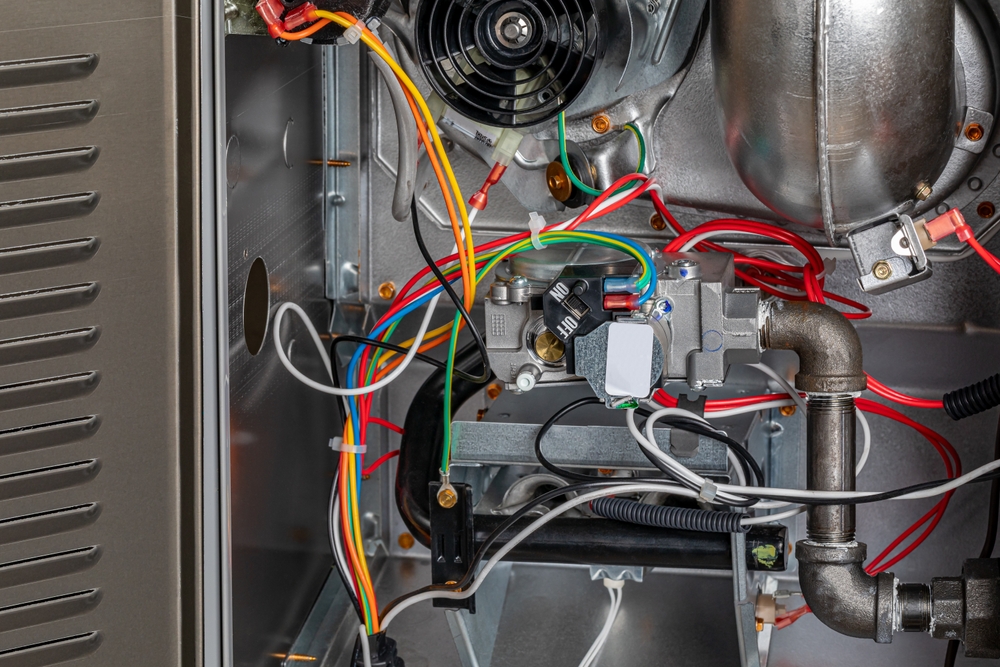If your furnace is connected to your home’s natural gas line, it needs the right gas pressure to prevent performance and safety problems.
Knowing a furnace’s proper natural gas pressure can help you spot problems. These problems include low efficiency, poor heating, and gas leaks.
Understanding Gas Pressure in Furnaces
Natural gas enters your home at a regulated pressure, typically 7 WC (water column). However, different appliances in your home are calibrated with their own pressure requirements.
Your natural gas furnace will have a fixed gas valve or a two-stage gas valve. This valve controls the gas flow into the unit.
Single-stage furnaces run at full power all the time, while two-stage furnaces can run at lower or full power. Two-stage furnaces use less gas than single-stage ones, and their variable output makes them more efficient and provides more even heating.
What Should the Gas Furnace Pressure Be?
Your furnace runs at about 3.5 WC. So, the pressure needs to be lowered before it can enter the unit.
A gas regulator valve controls the amount of gas flow and pressure. It ensures your system gets the right amount for efficient operation and prevents your furnace’s gas pressure from being too high or too low.
Proper natural gas pressure for a furnace heats your home or business evenly. It also helps your furnace burn cleanly. This can lower your energy costs.
What Causes Improper Gas Pressure?
If you’re experiencing furnace issues, the first thing you should do is check if the gas furnace pressure switch is set correctly.
If you notice low furnace pressure, the valve might be corroded, blocking the gas flow. You might also have unwanted critters in your furnace. Small rodents, like mice, can crawl through small openings, including places like your exhaust pipe or an exposed vent.
High furnace gas pressure can be caused by:
- Clogged vents
- Restricted airflow
- Dirty air filter
You can quickly fix these common issues by changing the air filter, cleaning the vents, and clearing the area around your furnace. However, more serious causes of high furnace pressure require an HVAC professional to repair or replace the furnace.
Broken or faulty furnace parts, such as a cracked heat exchanger, dirty burners, or a bad pressure switch, can cause uneven gas pressure. Gas supply issues, such as leaks, can also cause high pressure.
These issues can result in a shortened furnace lifespan and early replacement.
Consequences of Incorrect Furnace Pressure
The wrong gas pressure can damage your furnace and create safety risks for your home or business.
Low furnace pressure can cause:
- Condensation
- Corroded internal parts
- Reduced efficiency
- Risk of carbon monoxide
- Frequent cycling
- Poor indoor air quality
High furnace pressure can cause:
- Overheating
- Damaged parts
- Inefficient combustion
- Reduced output
- Higher energy bills
- Early system replacements
Maintaining the Correct Furnace Gas Pressure
It’s important to determine if a gas pressure issue is coming from the gas line or the furnace itself. If other natural gas appliances are working, then it’s time to schedule a furnace inspection and repair.
Attempting to check the gas pressure of a natural gas furnace can damage your furnace and cause gas leaks, leading to health risks and explosions.
When To Call an HVAC Professional
It is not recommended to try to check your furnace gas pressure yourself. HVAC professionals have the tools and knowledge to measure the pressure adequately and safely.
They will also be able to adjust the pressure, so your furnace operates properly. To do so, the HVAC tech will:
- Turn off the gas supply and electricity to the furnace
- Attach the manometer to the furnace pressure gauge
- Turn the burner on and adjust the screw to increase or decrease the pressure
- Match the manufacturer’s recommended furnace pressure
They can also perform any other furnace repairs they find when inspecting your system.
Need Furnace Services? Choose Thornton
If you have furnace problems or need your yearly service, the NATE-Certified team at Thornton can check your furnace for gas pressure issues.
Our HVAC experts can replace the gas regulation valve. They will ensure the new part works well with your furnace and is properly calibrated. We also offer new single and two-stage furnaces.
It can be easy to overlook the importance of having the correct gas pressure for your furnace. But it can mean the difference between an effective heating system and a hazard to your home or business.

